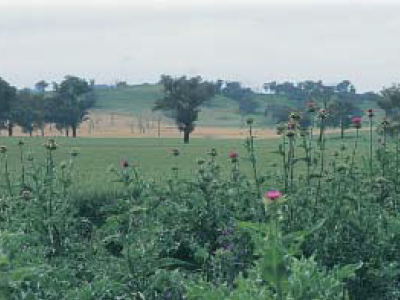Pest plant - Variegated thistle
- Fact sheet
- August 2015

Variegated thistle (Silybum marianum) is an annual herb also known as St Mary’s thistle, milk thistle or bull thistle. It is a competitive pasture weed.
Description
- erect annual or biennial herb to 2.5m with a thick taproot
- stems branch from the base, thick but hollow or full of pith, ribbed with small spines and often downy with cobwebby hairs
- leaves have a shiny, mottled green upper surface and a slightly hairy lower surface; they are deeply divided into toothed segments with short spines along the edges
- flowering heads are 4-8cm and round, packed with purple florets to 5cm long, protruding from the head and ending in spines
- seeds are long and shiny, 6-8 mm, mottled black and grey with many fine bristles, joined together in a ring attached to one end of the seed.
Why is it a problem?
- will eliminate most plants by shading them out, and via competition for moisture and nutrients
- unpalatable and not readily grazed by stock unless sprayed or cut
- of little nutritional value and becomes poisonous under certain conditions
- spines of the plant can cause physical injury and restrict stock movement.
- dense stands of variegated thistle may also harbour vermin.
Distribution
- Eyre Peninsula – isolated plants
- Northern pastoral – isolated patches in towns only
- Northern agricultural districts and Yorke Peninsula – isolated plants, more common in higher rainfall areas
- Murray Mallee – small isolated patches
- South East – scattered in upper south east, widespread in lower south east
- Central region – scattered patches in higher rainfall areas.
Ecology
- prefers heavy, fertile soils with high nitrogen, needs bare or disturbed ground to germinate
- no growth in winter, then grows rapidly in spring before producing flowering stems
- flowering starts in October, continuing into early summer
- plants die during summer, dry stems can remain standing for several months.
How it spreads
- reproduces only by seeds that germinate after autumn rain but can remain viable in the soil for up to 9 years.